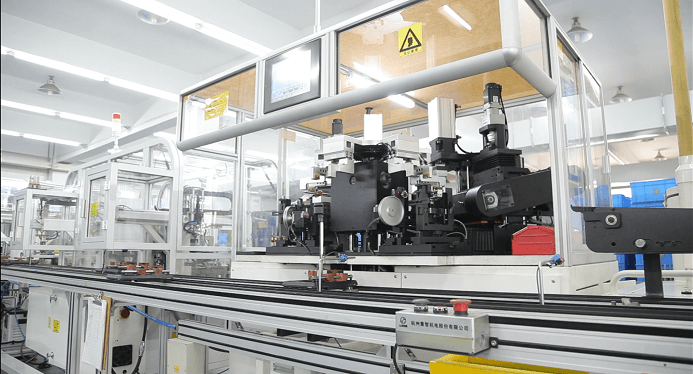A linear actuator creates motion in a straight line. It is widely used in machine tools and industrial applications. Recently, with the rise of electric linear actuators, more and more industries have begun to use them to automate their applications. For example, linear actuators are used in the renewable energy industry to tilt panels towards the sun for optimal exposure and in the medical industry to actuate hospital beds.
Progressive Automations is a linear actuator manufacturer and is a world leader. The manufacturing process of our actuators follows very strict guidelines, and they are extensively reviewed by our product and manufacturing engineers.
The Manufacturing Process
To make a linear actuator, the manufacturing process starts with the electric motor. Each electric motor has two main components:
- Stator: A stationary permanent magnet.
- Rotor: Sits in the middle of the stator and is subject to the magnetic field created by the stator, thereby, causing it to spin in motion.
Each part is carefully crafted from a fully automated assembly line within the electric linear actuator factory. From the winding of the copper coils on the rotor, to the insertion of the shaft screw into the motor. Every step is carefully monitored, and each batch examined by our quality assurance experts.

Different parts of the motors are produced concurrently, with each linear actuator assembly line being optimized to complete their designated parts at the same time to complete the larger component. Mechanical arms and conveyor belts transport raw materials and completed parts to the next section of the production line. From the electric linear actuator factory floor, thousands of moving parts continuously travel from one end of the floor to another like a busy highway with thousands of moving cars trying to reach four corners of a city.
The final Progressive Automations linear actuator assembly process is more hands-on. Professionally trained assembly workers follow a manufacturing document made by engineers to assemble the final pieces. Each step is carefully monitored with quality assurance experts examining the finished components before moving to the next step.
Quality Control
After the actuators are fully assembled, they are sent to the Quality Control team for first article inspection. The first article inspection will verify the accuracy of the dimensions, making sure every parameter is met. The first article unit will go through stress testing to ensure they meet the operating temperature, IP rating, and duty cycle requirements. After the Quality Control team is satisfied with the result, the entire batch is approved to be shipped out to our distribution center.

Once they have arrived at our distribution center, they will be received into our warehouse. A product engineer will take a few units from the batch to perform another inspection to ensure the units meet all the specification requirements and were not damaged during transport. They will then be added to our in-stock units and ready to be purchased by our clients. When they are purchased, our logistic team will test the units again before carefully packing them and preparing them to be shipped. Finally, they will be sent to our customers to fulfill whatever roles they may be needed in various types of applications. We at Progressive Automations pride ourselves as a world-class linear actuator manufacturer. We provide excellent customer service and our engineers are constantly working on research and development to improve our products. We employ a team-based approach and study the use of best practices. In the coming years, we will continue to provide top-notch service to our clients, and if you are interested to find out more about our units, take a look at our selection of actuators.
Once they have arrived at our distribution center, they will be received into our warehouse. A product engineer will take a few units from the batch to perform another inspection to ensure the units meet all the specification requirements and were not damaged during transport. They will then be added to our in-stock units and ready to be purchased by our clients. When they are purchased, our logistics team will test the units again before carefully packing them and preparing them to be shipped. Finally, they will be sent to our customers to fulfil whatever roles they may be needed in various types of applications.
How do you power a 12v linear actuator?
"12v" is better known as "12 VDC" and refers to when direct current is used to power actuators that have a DC motor. For a standard linear actuator, there will be two lead wires that extend from the motor; a positive wire (usually red) and a negative wire (usually black). By using a 12 VDC power supply (a car battery, for example), if you connect the + terminal to the red wire and - terminal to the black wire, the motor will rotate and the stroke rod will extend. If we reversed the polarity and applied - to the red wire and + to the black wire, voltage to the motor will have the motor spin in the opposite direction, making the stroke rod retract. This is the basic function of applying power to a 12 VDC linear actuator, but keep in mind that the amperage will have to be sufficient for the actuator's current draw. You must meet the threshold of the linear actuator's motor, but you typically can't use 'too much' amperage from the power source.
Final Word
For a detailed look at our linear actuator assembly process and manufacturing facilities, watch the video below.
At Progressive Automations, we pride ourselves as a world-class linear actuator manufacturer. We provide excellent customer service, and our engineers are constantly working on research and development to improve our products. We employ a team-based approach and study the use of best practices. In the coming years, we will continue to provide top-notch service to our clients, and if you are interested to find out more about our units, take a look at our selection of actuators.




